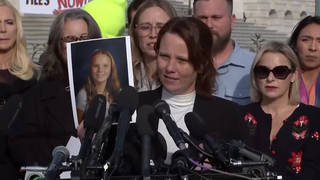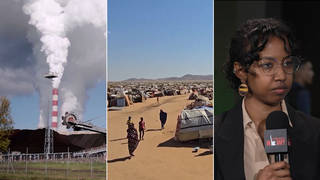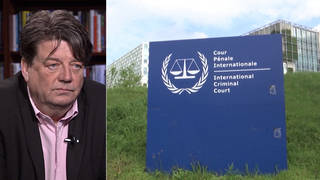
Topics
Author Stephen Kinzer discusses his new book, “Overthrow: America’s Century of Regime Change from Hawaii to Iraq.” In it, he writes that the invasion of Iraq “was the culmination of a 110-year period during which Americans overthrew fourteen governments that displeased them for various ideological, political, and economic reasons.” [includes rush transcript]
“The invasion of Iraq in 2003 was not an isolated episode. It was the culmination of a 110-year period during which Americans overthrew fourteen governments that displeased them for various ideological, political, and economic reasons.”
So writes author Stephen Kinzer in his new book “Overthrow: America’s Century of Regime Change from Hawaii to Iraq.”
Kinzer writes that “The “regime change” in Iraq seemed for a time — a very short time — to have worked. It is now clear, however, that this operation has had terrible unintended consequences. So have most of the other coups, revolutions, and invasions that the United States has mounted to depose governments it feared or mistrusted.”
- Stephen Kinzer, author of “Overthrow: America’s Century of Regime Change from Hawaii to Iraq.” He is a former New York Times foreign correspondent and author of several books, including “All the Shah’s Men” and “Bitter Fruit.”
Transcript
AMY GOODMAN: Stephen Kinzer joins us today in Chicago. He is a veteran New York Times foreign correspondent, author of several books, including All the Shah’s Men and Bitter Fruit. He has just recently left the New York Times. We welcome you to Democracy Now!
STEPHEN KINZER: It’s great to be with you, Amy.
AMY GOODMAN: It’s good to be in your city, Stephen.
STEPHEN KINZER: Love it!
AMY GOODMAN: Well, you are looking at 14 coups that the U.S. was involved with. What was the primary reason for the U.S. government’s involvement in overthrowing other countries’ governments?
STEPHEN KINZER: A lot of these coups have been studied individually, but what I’m trying to do in my book is see them not as a series of isolated incidents, but rather as one long continuum. And by looking at them that way, I am able to tease out certain patterns that recur over and over again. They don’t all fit the same pattern, but it’s amazing how many of them do.
You ask about the motivations, and that is one of the patterns that comes through when you look at these things all together. There’s really a three-stage motivation that I can see when I watch so many of the developments of these coups. The first thing that happens is that the regime in question starts bothering some American company. They start demanding that the company pay taxes or that it observe labor laws or environmental laws. Sometimes that company is nationalized or is somehow required to sell some of its land or its assets. So the first thing that happens is that an American or a foreign corporation is active in another country, and the government of that country starts to restrict it in some way or give it some trouble, restrict its ability to operate freely.
Then, the leaders of that company come to the political leadership of the United States to complain about the regime in that country. In the political process, in the White House, the motivation morphs a little bit. The U.S. government does not intervene directly to defend the rights of a company, but they transform the motivation from an economic one into a political or geo-strategic one. They make the assumption that any regime that would bother an American company or harass an American company must be anti-American, repressive, dictatorial, and probably the tool of some foreign power or interest that wants to undermine the United States. So the motivation transforms from an economic to a political one, although the actual basis for it never changes.
Then, it morphs one more time when the U.S. leaders have to explain the motivation for this operation to the American people. Then they do not use either the economic or the political motivation usually, but they portray these interventions as liberation operations, just a chance to free a poor oppressed nation from the brutality of a regime that we assume is a dictatorship, because what other kind of a regime would be bothering an American company?
AMY GOODMAN: Stephen Kinzer, I want to begin where you do in the book, and that is, with Hawaii.
STEPHEN KINZER: Many Americans I don’t think realize that Hawaii was an independent country before it was brought into the United States. In brief, this is the story. In the early part of the 19th century, several hundred American missionaries, most of them from New England, sailed off to what were then called the Sandwich Islands to devote their lives to, as they would have put it, raising up the heathen savages and teaching them the blessings of Christian civilization.
It wasn’t long before many of these missionaries and their sons began to realize that there was a lot of money to be made in Hawaii. The natives had been growing sugar for a long time, but they had never refined it and had never exported it. By dispossessing the natives of most of their land, a group that came from what was then called this missionary planter elite sort of left the path of God, went onto the path of Mammon and established a series of giant sugar plantations in Hawaii, and they became very rich from exporting sugar into the United States.
In the early 1890s, the U.S. passed a tariff that made it impossible for the Hawaiian sugar growers to sell their sugar in the U.S. So they were in a panic. They were about to lose their fortunes. And they asked themselves what they could do to somehow continue to sell their sugar in the U.S.
They came up with a perfect answer: We’ll get into the U.S. How will we do this? Well, the leader of the Hawaiian revolutionaries, if you want to call them that, who were mostly of American origin, actually went to Washington. He met with the Secretary of the Navy. He presented his case directly to the President of the United States, Benjamin Harrison. And he received assurances that the U.S. would support a rebellion against the Hawaiian monarchy.
So he went back to Hawaii and became part of a triumvirate, which essentially carried out the Hawaiian revolution. He was one part of the triumvirate. The second part was the American ambassador, who was himself an annexationist and had been instructed by the State Department to do whatever he could to aid this revolution. And the third figure was the commander of the U.S. naval vessel, which was conveniently anchored right off the shores of Honolulu.
This revolution was carried out with amazing ease. The leader of the Hawaiian revolutionaries, this missionary planter elite, simply announced at a meeting one day, “We have overthrown the government of Hawaii, and we are now the new government.” And before the queen was able to respond, the U.S. ambassador had 250 Marines called to shore from the ship that was conveniently off the coast of Honolulu and announced that since there had been some instability and there seemed to be a change of government, the Marines were going to land to protect the new regime and the lives and property of all Hawaiians. So that meant that there was nothing the queen could do. The regime was immediately recognized by the United States, and with that simple process, the monarchy of Hawaii came to an end, and then ultimately Hawaii joined the U.S.
AMY GOODMAN: The queen called in ambassadors from other countries for help?
STEPHEN KINZER: The queen was a little bit shocked by all this, as were her cabinet ministers. In fact, they appealed to the United States and asked, “What instability is there? Who’s in danger? Tell us, and we’ll protect them.” The queen had about 600 troops at her disposal. That was the whole Hawaiian military force. And her cabinet ministers actually called the ambassadors from foreign countries in Honolulu — there were about a dozen of them then — and said, “What should we do? Do you think we should fight the Marines?” And the ambassadors quite prudently told her that that would be foolish. “You should just accept it and then try to regain your throne by some other means.” That never proved possible. But even then, it was clear to the ruler of this small, weak country that there was no hope in resisting U.S. military intervention.
AMY GOODMAN: It still took a few years before Hawaii was ultimately annexed.
STEPHEN KINZER: It’s a very interesting story. Immediately after the revolution, the revolutionaries went back to Washington and, sure enough, President Harrison, as he promised, submitted to the U.S. Congress a law to bring Hawaii into the U.S., but there was a great resistance to this when it was understood how the coup was organized and on whose behalf it was organized, so the Congress did not immediately approve the annexation of Hawaii.
And right at that time, the presidency changed. The Republican, Benjamin Harrison, was out of office, and the new president, a Democrat, Grover Cleveland, came in. He was against annexation. He was an anti-imperialist. He withdrew the treaty. And that meant that Hawaii had to become an independent country for a few years, until the next Republican president came into office, McKinley. And then, at the height of the Spanish-American War, when the U.S. was taking the Philippines, Hawaii was presented to the U.S. as a vital midway station between California and the Philippines. And it was at that time, five years after the revolution, that Hawaii was actually brought into the United States.
AMY GOODMAN: We’re talking to Stephen Kinzer. So, first came the missionaries, then came the Marines.
STEPHEN KINZER: Yeah, exactly. Sometimes we hear the phrase “Business follows the flag.” But in my research, I found that it’s actually the opposite. First comes the business operations, then comes the flag. It’s the flag that follows business.
AMY GOODMAN: We’re going to take a break, and then we’re going to come back to this discussion about, well, the title of his book is Overthrow: America’s Century of Regime Change from Hawaii to Iraq.
[break]
AMY GOODMAN: We’re broadcasting from Chicago, where Stephen Kinzer is based, longtime foreign correspondent for the New York Times, author of a number of books, including All the Shah’s Men, about Iran, Bitter Fruit, about Guatemala. His latest is Overthrow: America’s Century of Regime Change from Hawaii to Iraq. He just recently left the New York Times. You talk about 14 countries that the U.S. intervened in: Hawaii, Cuba, the Philippines, Puerto Rico, Chile, Honduras, Iran, Guatemala, South Vietnam, Afghanistan, Iraq, Panama. Let’s talk about Cuba. What happened?
STEPHEN KINZER: The Cuban story is really a fascinating one, partly because it illustrates one of the main themes of my book, and that is how these interventions in the long run always produce reactions and ultimately lead to the emergence of regimes that are much more anti-American than the regimes we originally set out to overthrow. Here was the story in Cuba. Americans have had their eye on Cuba for a long time, ever since Thomas Jefferson was president. But it was in 1898 that this attachment to the cause of Cuba Libré really seized the hearts of many Americans.
Bear in mind that in 1898, the Cuban economy was totally dominated by Americans. It was a big sugar producer, and all the sugar plantations in Cuba were owned by Americans. Also, it was a very big market for American manufactured goods. About 85% of anything you could buy in Cuba had been made in the United States, so American business had very big interests there.
Now, Cuban patriots spent much of the late 19th century rebelling against Spanish colonial rule. In 1898 they seemed very close to succeeding. This was a little bit troubling to some of the American interests in Cuba, because the revolutionaries were also social reformers. They advocated land reform, which would have meant breaking up the big sugar plantations owned by Americans. They also supported a tariff wall around Cuba to allow the growth of domestic manufacturing, which would have made it more difficult for American companies to export their goods to Cuba.
AMY GOODMAN: And what year was this?
STEPHEN KINZER: These are in the late 1890s. So in 1898, the American press, in some ways excited by whisperings from American businessmen active in Cuba, began a campaign to portray Spanish colonial rule in Cuba as the most unspeakably brutal tyranny that could be imagined, and the American public was whipped up into a fervor about this. The fervor intensified when the U.S. battleship, Maine, was blown up in Havana harbor. “Our Warship Was Blown Up by an Enemy’s Infernal Machine.” That was the headline in the New York Journal that I reproduce in my book. Actually, it wasn’t until 75 years later that the Navy convened a board of inquiry, which turned up the fact that the Maine was actually blown up by an internal explosion. The Spanish had nothing to do with it, but we didn’t know that then, and the press seized on this to intensify the anger in the U.S.
Now, the Americans then decided we would send troops to Cuba to help the patriots overthrow Spanish colonialism, but the Cuban revolutionaries were not so sure they liked this idea. They didn’t know if they wanted thousands of American troops on their soil, because what would happen after the victory was won? In response to this concern, the U.S. government, the Congress, passed a law, the Teller Amendment, which said very explicitly, “We promise Cuba that the moment independence is won, all American troops will be withdrawn, and Cuba will be allowed to become fully independent.”
After that law was passed, the Cuban rebels agreed to accept American aid. American soldiers went to Cuba, including, famously, Teddy Roosevelt, who had his own uniform personally designed for him by Brooks Brothers in New York. In the space of essentially one day of fighting, the Spanish colonial rule was dealt its final death blow, Spain surrendered Cuba, and Cuba prepared for a huge celebration of its independence.
Just before that celebration was about to be held, the Americans announced that they changed their mind, that the Teller Amendment had been passed in a moment of irrational enthusiasm and that actually Cuban independence was not a very good idea, so the American troops were not withdrawn. We remained in Cuba for some decades, ruling it directly under U.S. military officers, and then, for a period after that, through local dictators.
Now, flash forward to 1959. That was when Fidel Castro’s revolution succeeded. Castro came down from the hills and made his very first speech as leader of the revolution in Santiago, and in that speech, which I quote in my book, he does not talk about what kind of a regime he’s going to impose, but he makes one promise. He says, “This time I promise you it will not be like 1898 again, when the Americans came in and made themselves masters of our country.”
Now, any Americans who might have read a report of that speech, I’m sure, would have been very puzzled. In the first place, they would have had no memory of what happened in 1898, but secondly, they would wonder, “What could an event 60 years ago possibly have to do with this revolution in Cuba today?” What they had failed to realize is that resentment over these interventions burns in the hearts and souls of people in foreign countries and later explodes violently.
It’s quite reasonable to say today that had we not intervened in Cuba and prevented Cuba from becoming independent, had we carried out our explicit promise to the Cubans in 1898, we would never have had to face the entire phenomenon of Castro communism all these last 40 years. Now, of course, we would love to have back a moderate democratic regime like the one that was going to come to power in Cuba in 1898, but it’s too late for that, and it’s an example of how when we frustrate people’s legitimate nationalist aspirations, we wind up not only casting those countries into instability, but severely undermining our own national security.
AMY GOODMAN: Now, something we see today, for example, in Iraq, is the critical role, not only of the U.S. government perhaps protecting U.S. corporations, but the role of the media in all of this. Going back to Cuba, what was the role of the media?
STEPHEN KINZER: The press played a really shameful role in the run-up to the Spanish-American War. The Americans had never been particularly fond of the Spanish rule in Cuba, but it wasn’t until the press, actually in a circulation war, decided to seize on the brutality, as they called it, of Spanish colonial rule in the summer of 1898 that Americans really went crazy.
Now, there’s one very interesting aspect of the Cuban press campaign that I think we see repeated periodically throughout American history, and that is, we never like to attack simply a regime. We like to have one individual. Americans love to have a demon, a certain person who is the symbol of all the evil and tyranny in the regime that we want to attack. We’ve had this with Khomeini, with Castro, with Qaddafi, various other figures over history.
Now, in the case of the Spanish-American War, we first thought we’d like to demonize the king of Spain, but there was no king of Spain. There was a queen, who was actually an Austrian princess, so she wouldn’t work. The regent, her son, was actually just a 12-year-old kid, so he wouldn’t work, either. So then, we decided to focus on the Spanish general, who was the commander of Spanish troops in Cuba, General Weyler, and for a time, Weyler was thought of as the epitome of all the carnal brutality that we attributed to Spanish colonialism.
We see this pattern again coming right up to the modern age, when we’re always looking for some individual to point at. The idea behind this is that the natural state of all people in the world is to have U.S.-style democracy and to be friendly to the United States. If they’re not, it must mean that there’s only one person or one tiny clique that is preventing the people in this country from being the way they naturally would be, and if we could only just remove this one individual or this tiny clique, the people in that country would return to the normal state of all people, which is to wish to have the U.S. system of government and politics and economics and to embrace the United States.
AMY GOODMAN: William Randolph Hearst, was he a key figure then?
STEPHEN KINZER: Hearst was a crucial figure, who very cleverly realized that he could push the circulation of his newspaper dramatically higher if he hammered away on jingoistic issues by pointing at foreign nations as constantly seeking to undermine the United States. There’s an undercurrent, which we’re still seeing today, of seeing the world in this very Hobbesian way, that there are terrible dangers everywhere, and it’s very important for the U.S. to go out and attack here and attack there before those dangers come to shore. Clausewitz, who I read a lot while I was researching my book, had a great phrase for this. He called it, “suicide for fear of death.” You are so afraid of what’s happening to you in the world or what might happen to you that you go out and launch operations, which actually produce the result that you were afraid might happen if you didn’t do these things.
AMY GOODMAN: Can you talk about John Foster Dulles, who he was, his role in these interventions, Guatemala, and just before that, Iran?
STEPHEN KINZER: One of the things I do in my book that I haven’t done in my previous books is focus a lot on Dulles. I really believe that Dulles was one of the key figures in shaping the second half of the 20th century, and I devote some time to try to analyze him and figure out why he played this role. First of all, Dulles spent almost all of his adult life as America’s most successful and most highly paid corporate lawyer. He represented all of the giant multinational corporations in America, not just United Fruit, but International Nickel and all sorts of resource conglomerates all over the world. So the whole way he saw the world was economics. He thought that American policy in the world should be oriented towards protecting American corporations.
Dulles also came from a family of clergymen. He was a deep religious believer. His father was a preacher. His grandfather had been a missionary in India, and this gave him another strain, which is very important in the American regime-change era, and that is this sense of religious mission, this belief that since the United States has been blessed with prosperity and democracy, we have, not just the right, but perhaps even the God-given obligation to go to other countries and share the benefits of all we have with them, particularly to countries that may not even be advanced enough to realize how much they want our political system. So Dulles saw the world in a strictly black-and-white way.
He saw, at that time, a communist conspiracy all over the world as working relentlessly to undermine the United States. For example, he opposed all cultural exchanges with any communist country. He tried for years to keep U.S. reporters from visiting China. He was against summit meetings of all kinds. He didn’t want agreement with communist countries on any subject, because he thought any agreement would be just a trick to get America to lower its guard.
Now, when Iran nationalized its oil industry, when Guatemala tried to restrict the operations of United Fruit Company, Dulles did not see this as a reflection of a desire by people in a foreign country to control their own resources. He rather saw it as an anti-American move, undoubtedly manipulated from the Kremlin, which had a much more profound goal than simply bothering an American company. This was just the beginnings of an anti-American attack.
Now, one of the things I ask in my book is: Why did we so tragically misjudge nationalist movements in developing countries, like Iran and Guatemala and later Chile? Why did we interpret them as part of an international conspiracy, which, as documents later proved, they were not?
I think it was for this reason. American statesmen and diplomats who study the history of diplomacy are actually studying the history of European diplomacy. We’re very Eurocentric. Our diplomats and our statesmen are very well versed in European political traditions. They’re familiar with alliance politics and wars of conquest and big powers that use small powers secretly for their own means, but the desire of poor people in poor countries to control their own natural resources has never been a part of European history. It’s not a syndrome that Americans who study Europe are familiar with, and that, along with an instinctive desire to protect American companies, I think led them to misjudge nationalist movements and misinterpret them as part of a global conspiracy to undermine the United States.
AMY GOODMAN: Or perhaps not care, but care about U.S. companies, as in Guatemala, United Fruit being able to have free reign.
STEPHEN KINZER: I think it was very much a sense that the companies must know what’s best for the United States in those countries, but in addition, we managed to persuade ourselves that a government that was bothering American companies must also be harassing and oppressing its own people, and this is an argument that I think is very well tailored to the American soul. You know, we really are a very compassionate people, and Americans hate the idea that there are people suffering in some faraway country. American leaders who want to intervene in those countries for very ignoble reasons understand this, and they use that motive, they play on the American compassion to achieve support for their interventions.
AMY GOODMAN: So talk about what fuels Iran today, the feeling Iranians have for America, based on the coup the U.S. was involved with in 1953.
STEPHEN KINZER: It’s hard to believe today that we could even use the word “Iran” and “democracy” in the same sentence, but the fact is Iran was a functioning, thriving democracy in the late 1940s and early 1950s. Because Iran nationalized its oil industry, rather than allow it to continue being exploited by foreigners, Iran became a target for foreign intervention, and the U.S. did overthrow the democracy of Iran in the summer of 1953.
We placed on the throne the Shah. He ruled for 25 years with increasing repression. His repression produced the explosion of the late 1970s, the Islamic revolution. That revolution brought to power a fanatically anti-American clique of mullahs who began their regime by taking American diplomats as hostage, has then spent 25 years oppressing its own people and doing whatever it could, sometimes very violently, to undermine American interests in the world, and that is the regime with which we are now approaching a very serious world crisis regarding the nuclear issue.
Now, had we not intervened in 1953 and crushed Iranian democracy, we might have had a thriving democracy in the heart of the Muslim Middle East all these 50 years. I can hardly wrap my mind around how different the Middle East might be now. This regime that’s now in power in Iran would never have come to power, and the current nuclear crisis would never have emerged. This is a great example of how our intervention ultimately leads us to regimes much worse than the ones we originally set out to overthrow.
Now, how do you think that people in Iran react when Americans point a finger at them and say, “You’re a tyranny over there. You’re a brutal dictatorship. You should have a democracy. You should have a free regime”? Well, they say, “We had a democracy here, until you came in and overthrew it.” Now, the United States today has some very legitimate complaints against the Iranian government, but we have to understand that Iranians also have some very legitimate complaints against us, and that should be a recognition that would lead us into negotiations with them at this point.
AMY GOODMAN: Stephen Kinzer, we’re going to have to leave it there for today, but next week, part two of this discussion on Overthrow: America’s Century of Regime Change from Hawaii to Iraq, looking at 14 coups of the last more than a century that the U.S. was involved with.












Media Options